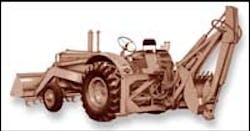The Evolution of Work Bull
In 1953, long-established Canadian agricultural equipment company Massey-Harris acquired the tractor-building business of Harry Ferguson Inc. Under the new name of Massey-Harris-Ferguson Inc., the company marketed a backhoe-loader outfit consisting of a Massey-Harris Work Bull industrial tractor fitted with a Davis model 500 loader and a model 185 backhoe attachment made by Mid-Western Industries of Wichita, Kan.
This hoe had a digging depth of 13 feet, a dump height of 10 feet, and was mounted on a sturdy rear-mounted frame incorporating independently controlled stabilizer feet. A range of bucket sizes from 12 to 36 inches was offered. The ¾-yard loader bucket could apply 3,000 pounds of breakout force.
This well-advanced machine for its day boasted a heavy king post with sealed ball bearings, horizontal hydraulic cylinders to swing the hoe, and hydraulic relief valves to protect the system from shocks. For hoe operation, a separate seat revolved with the hoe boom so the operator always faced his work. The entire hoe and frame assembly could be easily detached to allow the tractor to be used by itself as a loader.
In 1957, Massey-Harris-Ferguson purchased Mid-Western Industries and changed the company's name to Massey-Ferguson Ltd. (M-F). This purchase marked the company's first move into industrial and construction equipment, and established Massey-Ferguson's Industrial Division at Wichita, Kan. Two years later, M-F replaced the earlier Work Bull tractors with a new backhoe-loader combination based on the 37-hp Massey-Ferguson 702 tractor with model 710 backhoe and 702 loader. It was one of the first to feature a sliding king post enabling flush digging alongside walls and fences.
Building on this successful start, the company broadened its backhoe-loader range to seven models by the end of the 1960s. These included the backhoe-loader combination model 250/252 based on the M-F 3303 tractor. This model offered digging depths down to 13 feet 6 inches and a 60-hp engine. Meanwhile, M-F expanded its earthmoving equipment line further with a number of significant purchases: an excavator factory at Aprilla, Italy, in 1968; the Lorain wheel loader line in 1971; and the Hanomag crawler tractor business in Germany in 1974.
The German group IBH owned Massey-Ferguson from 1980 until 1983 when IBH collapsed in bankruptcy. After this, the company re-established itself, but built only skid-steer loaders and backhoe-loaders. Its ownership changed several times, and its name changed to Fermec International Ltd. in 1992, based in Manchester, England. The Fermec brand of backhoe-loader was distributed worldwide through former Massey-Ferguson outlets. From 1994, Kobelco America sold Fermec machines under the TLK brand name in the United States. In 2001, Terex acquired Fermec and continues the backhoe-loaders under the Terex brand name.
You can read more about the evolution of construction equipment in Keith Haddock's illustrated book, "The Earthmover Encyclopedia," available in most book stores. Also, consider a membership in the Historical Construction Equipment Association, at www.hcea.net .


